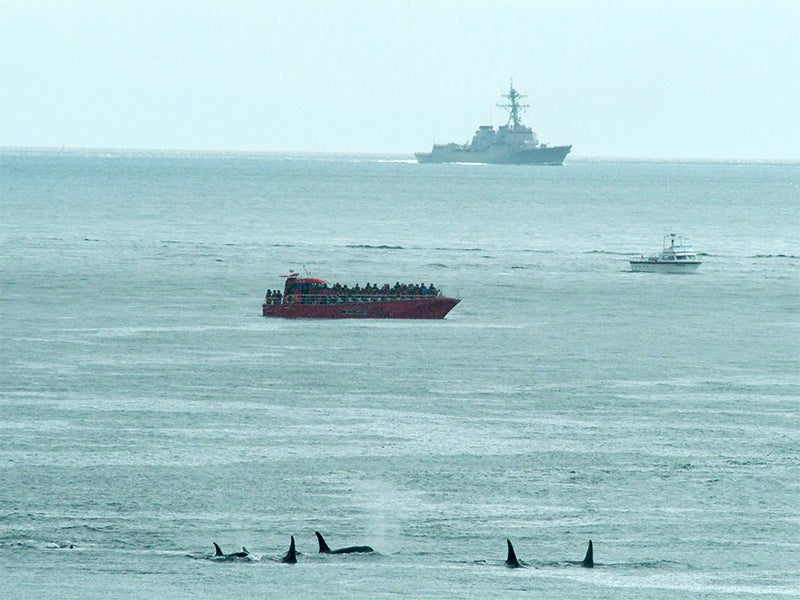Protecting Marine Eardrums
Navy training is essential to national security, but there's a way to minimize the harm that it inflicts on marine mammals.

This page was published 11 years ago. Find the latest on Earthjustice’s work.
Echolocation, the location of objects by reflected sound, is a mouthful. It is also something of a miracle.
For marine mammals, it’s how they communicate with each other, how they avoid perils, and how they locate food. Without healthy, functioning ears and sound-making systems, they are lost.
When their hearing is injured, marine mammals sometimes beach themselves and perish, they can starve, and their breeding behavior can be disrupted. Testing of sonar systems has injured countless whales, dolphins and other marine mammals. They are vulnerable to being struck by ships. Sea turtles are harmed by sonar blasts as well, which can kill by damaging the creatures’ lungs.
Sad to say for whales and dolphins, humans began to investigate the miracle of echolocation in the 1800s, though the term was not coined until 1944. They started equipping ships and submarines with man-made sonar systems about this time, for several purposes, including military ones—to find enemy ships, for example—and to search for whales to harpoon.
The U.S. Navy is a big player in the oceans, of course. It insists on constant testing and training, pointing out that modern submarines are very quiet and difficult to detect. Unfortunately, the Navy’s sonar activities have injured and killed many marine mammals and turtles, and it’s not just our Navy. NATO forces have been implicated in harm to marine mammals, as have other navies.
And here we come to a distressing theme: Some military agencies seem to consider themselves above environmental laws.
For years, Earthjustice has worked to protect marine creatures from overzealous military activity. A 2010 suit reined in this activity in the Northwest. Recently, Earthjustice sued again to challenge a new Navy five-year sonar plan, arguing that the plan violates three federal statutes. By the Navy’s and the National Marine Fisheries Service’s own estimates, the exercises will involve a quarter of a million explosions that, along with vessel strikes and sonar damage, are expected to kill about 155 marine mammal and cause about 2,000 permanent injuries of various kinds. The suit argues that there are other ways to achieve the Navy’s stated objectives concerning sonar and keep the country safe and secure.
As Earthjustice attorney David Henkin says, we don’t want to stop the Navy’s activities, just modify them to minimize harm to whales, dolphins, and other creatures.
“The Navy’s claims that taking reasonable steps to protect marine mammals would threaten national security ignore the fact that the Navy’s training and testing area in Hawai‘i and Southern California waters is as large as the combined land area of all 50 United States,” says Henkin. “The notion that limiting training in a few small areas to reduce the number of marine mammal deaths and permanent injuries would leave the U.S. vulnerable to attack doesn’t stand up to scrutiny.”
Henkin, incidentally, has some considerable experience at the military/conservation interface. He has been working successfully for many years to get the Army to obey the law in regards to terrestrial live-fire training on O`ahu. The training has damaged trees and wildlife, which includes more than 40 endangered species of plants and animals, and Native Hawaiian sacred sites.
Says Henkin, “The Army similarly claimed that live-fire training at Makua was vital to national security, yet, despite a ban on such training for 13 of the last 16 years (during which time Hawai‘i-based soldiers repeatedly and successfully deployed to combat in Afghanistan and Iraq), the Republic is still standing.”
National security is important; no one disputes that. But keeping healthy populations of wildlife, including those that navigate with the assistance of echolocation, is important as well. Ours is a nation of laws and those laws apply to the military just as they do to civil society.
The California Regional Office fights for the rights of all to a healthy environment regardless of where in the state they live; we fight to protect the magnificent natural spaces and wildlife found in California; and we fight to transition California to a zero-emissions future where cars, trucks, buildings, and power plants run on clean energy, not fossil fuels.
Established in 1988, Earthjustice's Mid-Pacific Office, located in Honolulu, Hawaiʻi, works on a broad range of environmental and community health issues, including to ensure water is a public trust and to achieve a cleaner energy future.
Established in 1987, Earthjustice's Northwest Regional Office has been at the forefront of many of the most significant legal decisions safeguarding the Pacific Northwest’s imperiled species, ancient forests, and waterways.